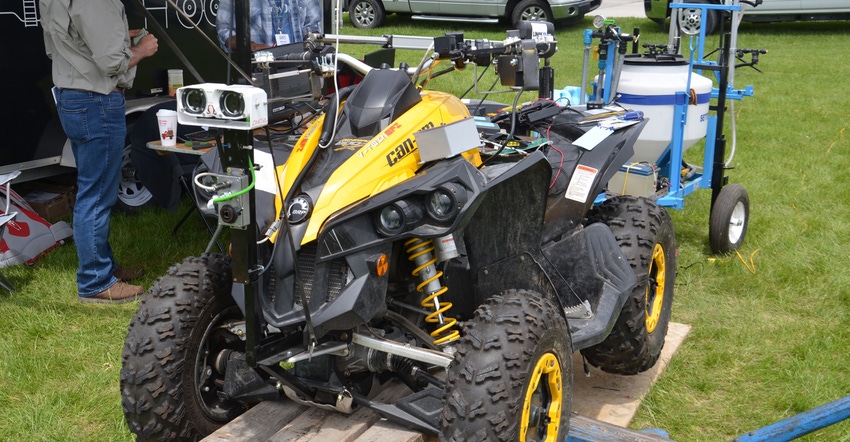
Imagine a machine going through a cornfield. It’s applying fertilizer to corn plants and spraying weeds. By the time it covers the entire field, the crop has been fertilized and sprayed all in one operation, and you were never in the field! What’s more, you only sprayed weeds if there were weeds, and only applied fertilizer where there were corn plants. Talk about saving time, energy, money and inputs.
This would have been the stuff of science fiction 20 to 30 years ago. Is it still radical thinking today? George Dyck, Franklin Ogidi and Eric Hawley don’t think so. These three students were part of a team from the University of Manitoba that developed a prototype rig and brought it to the AgBot competition at the Purdue University Agronomy Center for Research and Education in May. The students were aided by Marcel Lehmann, a biosystems engineering technician. The annual competition is sponsored by Garrish Farms, Rockville, Ind., and the Purdue College of Agriculture.
The students say the technology isn’t ready for plug-and-play commercial use. There are still bugs to work out. But they see potential.
The concept
The Manitoba team started with a small ATV to build their autonomous vehicle. RTK differential correction for GPS helps navigate it within the field.
“We mounted two cameras out front,” Dyck says. “If the cameras see corn and send a signal to the applicator, it sprays fertilizer. If it sees weeds, it pulls from the herbicide spray tank and sprays weeds.”
Does it work? The team acknowledges that it tended to work better in greenhouse and precompetition testing, but it does work. The secret is distinguishing between weeds and corn, Ogidi says. He rated accuracy in the field last spring at about 55%.
They’ve designed their unit to work best in 6- to 12-inch-tall corn, Ogidi adds. Normally at that stage, weeds should be shorter than corn. The trick is seeing weeds under the corn.
One of their goals is training the machine to recognize one of three types of weeds when determining when to spray herbicides, Ogidi says. Training the machine involves artificial intelligence and takes time to accomplish.
The students aren’t the only ones interested in developing weed or pest recognition programs using artificial intelligence. A Bayer scientist at the 2019 Farm Progress Show demonstrated early technology trained by artificial intelligence to recognize and report specific soybean diseases. That device also isn’t ready for primetime application.
Future direction
The students believe the type of technology they’re developing could play a future role in agriculture once various developmental issues are resolved. Time and dedication will produce results, they believe.
“Perhaps one of the biggest obstacles is learning how to make the machine trustworthy,” Dyck says. “We must trust that it can operate on its own and do what it’s programmed to do.
“Then farmers will need to trust the technology. There is lots of promise in this technology. It will take more time in development to make it practical.”
About the Author(s)
You May Also Like




